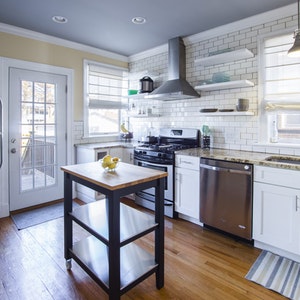- 95 reads

If eco-friendliness is your mission, where better to start than in the kitchen? Switching things up to save the environment is as good a cause as any, and you might want to get in on that. Eco-friendly options have a reputation for being expensive and difficult to install, but nowadays it's become a cakewalk. Here are some ways to improve your kitchens carbon footprint.
1. Efficient cooking
Long gone are the days of preheating the oven. Once upon a time, you had to turn on your oven way before you put any food inside it, wasting a bit of energy before being sure that it's warm enough to cook in. Nowadays, preheating has become obsolete. Ovens have become more efficient than ever before. You can put your uncooked food inside immediately and it'll do the job without any delay.
To maximize efficiency, you should make full use of the space in your oven. The heat isn’t going anywhere, so you might as well cook several things at once. Another thing to consider is not using your oven too often. Cut the baked goods and go for some raw vegetables that you can put in salads.
2. Buy in bulk
Being efficient is knowing what you’ll need way before you even get a chance to use it. This goes double for food. Buying everything in bulk will provide you with several green benefits. If you buy any product in plastic packages, this way you will be using way less plastic than if you bought several individual packages. Keeping an eye on the environment is good, and less plastic waste is the way to go.
Getting lots of materials ahead of time also frees up your schedule. Instead of shopping every day you might go pick up groceries every other day instead. Let’s not forget the other kind of green you’re saving when purchasing in bulk. Stores sell things cheaper when they’re bought in bulk.
3. Good cabinets
They don’t seem like the most sinister parts of your kitchen, but they can cause issues. Cabinets hold the things you put your food and drinks in, so having them be non-toxic is a pretty good goal. Most wood cabinets aren’t pure wood, they are also made with urea-formaldehyde which can evaporate slightly toxic fumes. Not too much of a health hazard, but it’s good to be safe when it comes to kitchens.
Solid wood is the way to go. Alternative materials like wheatboard can also work, just make sure any finishes are done with non-toxic materials. Leaks and mold are a very real danger if the cabinets aren’t well designed and if they’re improperly cleaned. When it comes to kitchen cabinets, the design is another thing to focus on. The better they look, the better you feel.
4. Renovation
A good craftsman is only as good as his tools allow him to be. If you’re aiming for the most efficient and green kitchen, sometimes an upgrade might be necessary. Some kitchens aren’t well insulated, others lack proper electrical wiring for appliances and so on. Replacing things that aren’t green should be on your bucket list when renovating. Nowadays you can buy lots of things with guaranteed carbon neutral scores. Things like green countertops made of recycled paper and bamboo are just one idea.
The kitchen is where the heart is and upgrading the area can be as taxing as heart surgery. The process takes a while and can be dangerous considering all the work with electrical wiring and heat. When it comes to kitchen or complete house renovation, it’s best to leave it to the professionals.
5. Reduce wastefulness
There’s no doubt about it, the kitchen is the most wasteful room in any house. Consider the packaging that food comes in, it's always some sort of plastic or foil that you have to throw away. The bags you use to carry the food are an essential tool, but they also count as waste that is harmful to the environment. Paper towels that you clean surfaces with are just as bad. It seems like everything a kitchen has is designed to be wasteful, but it doesn’t have to stay that way.
If you can buy fresh produce over packaged, consider it your duty to the environment. Bring your own re-useable bags to hold groceries in. It’s not much of a hassle to bring an empty bag with you when you go to the store. Paper towels should be replaced with actual towels or rags that can be used for cleaning just as well as their paper counterparts.
Conclusion
Going green is mostly about saving the environment, but let’s not forget the many other benefits you get from healthy alternatives. Using fewer pollutants means your air and food are much cleaner. Eco-friendly machines are usually more efficient, meaning your wallet is also spared. With these things in mind, it’s hard to go wrong with going green.

